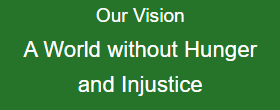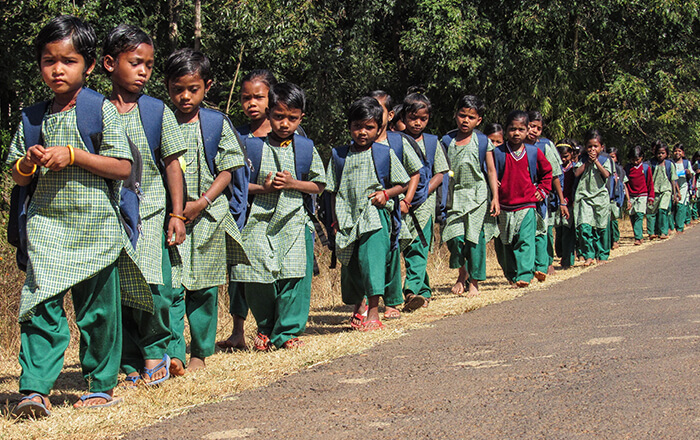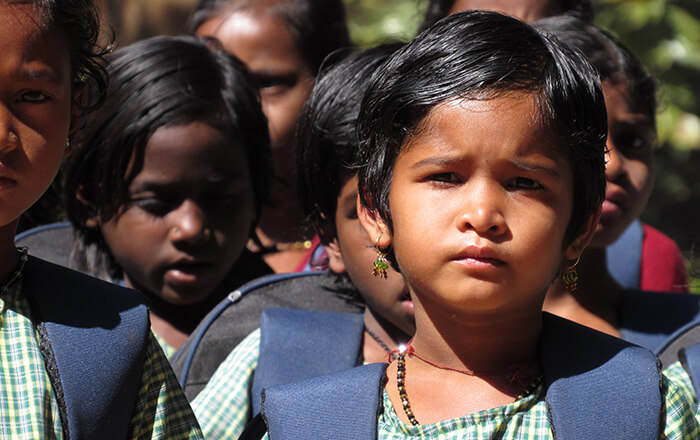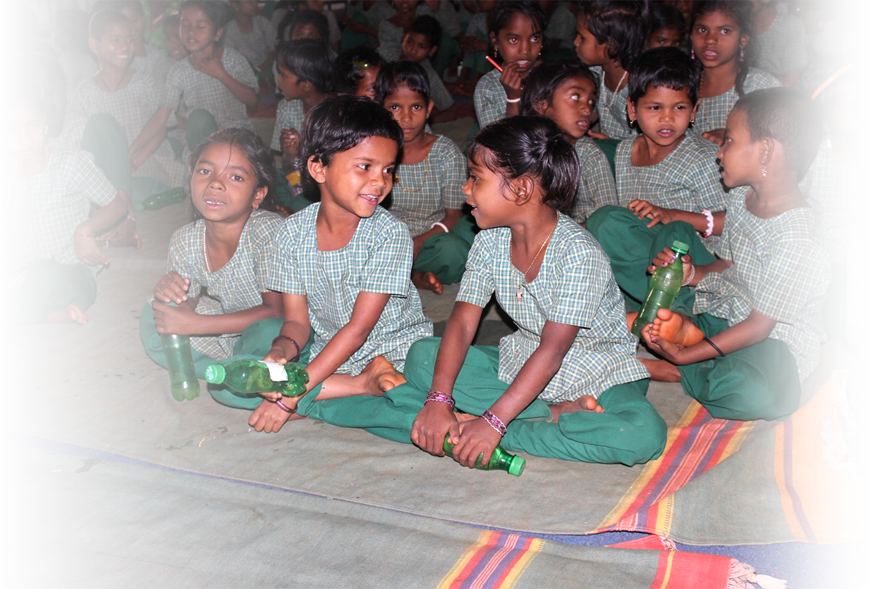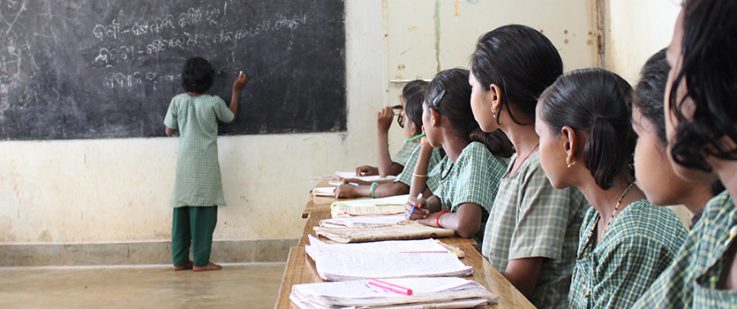
PRIMARY EDUCATION
by :|
Remote tribal communities have faced multiple exclusions for generations. Agragamee’s programme of primary education seeks to understand and address some of the major causes of this exclusion. Located in some of the most underdeveloped tribal districts of Odisha, it is designed for children of economically deprived sections of the population, who are first generation school goers. It is being increasingly acknowledged that low performance in education and poor socio-economic standards are self-reinforcing characteristics that tie communities across the world to low income and poverty. Although poor performance in school does not automatically stem from disadvantage, the socio-economic status of students and schools does exert a powerful influence on learning outcomes. School education thus tends to reproduce existing socio-economic patterns, rather than create a more equitable distribution of learning opportunities and outcomes. This is more apparent in a large and diverse country like India, where class, caste and geographical divides enable a few to access the best education in the world, while a staggeringly large majority of children struggle with basic learning.
RECENT POST
This has been evidenced in several reports and studies, across the country. The Pratichi Report (2002) underlines the overarching need to overcome the rigid class divisions that blight the basic rights of children from economically and socially disadvantaged backgrounds, the PROBE (Public Report on Education) Report underscores the close links of quality education with health, social progress and an active and participative democracy, as well as social justice. Much more recently, the ASER, (Annual Survey of Education Report) has underlined that while girls from poor rural backgrounds face a double disadvantage, children from poorer families in rural as well as urban areas score much worse than their more fortunate counterparts.
The double whammy traps the socio-economically underdeveloped communities in a spiral of poverty and poor opportunities. The PISA (Program of International Student Assessment) 2012 outlines the clear links between socioeconomic status of the parents and the ability of the children to perform well in school, specially in the crucial areas of reading, maths and science. It states: “Parents may not always have the tools and background to support their children’s cognitive and psychosocial development throughout their school years. Parents level of education, [thus] has a multifaceted impact on children’s ability to learn in school.” This situation is further compounded by poorly qualified and ill-motivated teachers, and poor quality of learning material. India has among the lowest expenditures on education, and pays its teachers extremely low wages. This is further aggravated by the pervasive poverty of most rural and specially tribal communities in India. Many of them cannot even afford to invest in their children’s education, in terms of the childs own time for the necessary minimum of 8 years of schooling. Many children are withdrawn from school half way through as is evidenced from the extremely high drop out rates in the primary school sections. The extremely low wages that prevail in the unorganised sector, often necessitate that children also work to add to the earnings of the family.
Thus we find that even at the end of 6 to 8 years of schooling, a very large number of children have very poor literacy. Literacy, or the ability to read and understand a written text, and to express oneself through writing is a crucial skill for any adult human being today, which enables her to lead a life of dignity and self reliance. Research shows that these kinds of reading literacy skills are more reliable predictors of economic and social well-being of communities than the number of years spent in school or in post-formal education. The lack of or poor levels of such skills also affects the educational development of the next generation, making this a self-perpetuating cycle. Across the world, it has been a challenge to ensure quality education for children of disadvantaged communities and first generation school goers. This is specially true in a country like India, where socio-economic disparities are wide, and the figure of 74.7% literacy thrown up by national census surveys masks a grim reality of non-performing schools, and low learning levels.
Those who can afford it help their children overcome problems of poor quality of teaching through private schools and tuitions; the less well off have no such options. This is true even in urban slum settlements, where Government schools provide very little real education. Teachers in these schools are poorly motivated, and also unable to assimilate the pedagogic inputs provided during in-service capacity building Programs. This often results in their inability to use learning material provided for the schools to the best effect. All this has resulted in India lagging far behind in educational achievements.
Consequently, a school education, where children are not provided the stimulus and opportunity to use their minds and cognitive abilities in creative and engaging ways, where too much emphasis is given to mechanical memorising, affects children’s mental development. It decreases interest and slows down learning, thus necessitating more than double the time normally required to acquire even the basic literacy skills. This is all the more prevalent in schools which cater to children from underprivileged and deprived communities, which are located in the inaccessible tribal regions.
These children have multiple disadvantages. Poverty often forces them to take time out of their school and studies and work to help their parents in earning a livelihood. In addition they suffer from chronic nutritional deficiencies, which makes them easy prey to diseases and further reduces their ability to study and work.
The challenge then is to break this self-reinforcing cycle of poverty and low learning levels, and provide a demonstration of a model for developing efficient and effective literacy competencies in communities, which are still in the process of creating first generation school goers.
The specific problems that these children face can be outlined as under:
(a) Children from Isolated and Remote regions : The districts of Koraput, Nabrangpur, Rayagada and Kalahandi in Odisha where Agragamee’s schools are located have had little or negative exposure to forces of modernisation, and remain highly isolated. The difference in male /female literacy rates in the districts under the project, as well as the difference in overall literacy rates of these districts, compared to the overall literacy rates of Odisha and India are striking.
| Districts | Female Literacy | Male Literacy | Total Literacy |
|---|---|---|---|
| Nabarangpur | 35.8 | 57.3 | 46.4 |
| Rayagada | 39.2 | 39.2 | 49.8 |
| Malkangiri | 38.3 | 59.1 | 48.5 |
| Kalahandi | 46.7 | 71.9 | 59.2 |
| Koraput | 38.6 | 60.3 | 49.2 |
| Balangir | 53.5 | 75.9 | 64.7 |
| Sonepur | 64.0 | 84.4 | 74.4 |
| Odisha | 64.1 | 64.1 | 73.9 |
| India | 65.5 | 82.1 | 74.0 |
If we look at the different regions of the state, the above districts, which comprise almost half the districts of South Odisha have a literacy rate of 57.6 and a female literacy rate of 45.9, against corresponding figures of 81.5 and 74.1 for coastal Odisha.
(b) Poorly-performing Government Schools : b. On the other hand, these figures hide a much grimmer reality of non-performing government schools, where reading levels of the students are near zero even beyond the primary school stage.
(c) Parents unable to Monitor Children’s Learning : c. The project thus primarily caters to children from villages with near zero literacy rates, where parents are able to check the timings and regularity of the teachers, but unable to monitor the learning levels of the children. Community based institutions like the School Management Committee and the Parent Teachers’ Association also perform very poorly in these regions due to ignorance and poor understanding.
(d) High Levels of Povertyd. The majority of the children come from families with high levels of poverty, resulting in inadequate food and affected by chronic malnutrition. Many of these children work with their parents, either in agricultural operations, or wage labour, helping to increase the family income. The parents of these children find it difficult to invest even in the minimum slates, note-books, and pens necessary for ‘free and compulsory’ education provided by the Government. The investment of time that the child is required to make is a costly investment, as it costs the child and the family the extra income that could supplement their meagre diet, or provide for other essentials like warm clothes for the winter etc. Often, a tribal family is able to afford education for only one child, while the others have to work to earn.
(e) Negative Incentive For Education : e. These necessary investments combined with the poor learning level of the child act as a negative incentive, and any contingency, like illness in the family etc. result in the child dropping out. This is specially true for girls, as women are inevitably overburdened with poorly remunerative work, whether it is in their own fields or house work, or as wage labour, and feel very much the need to have their daughters as helping hands.
(f) Linguistic Barriers : f. In the tribal districts, many communities have mother tongues different from the mainstream Odiya. These children find it extra hard to cope with school education, where teachers are insensitive to linguistic difference. Special provisions need to be made to enable these children to learn in the mainstream language.

